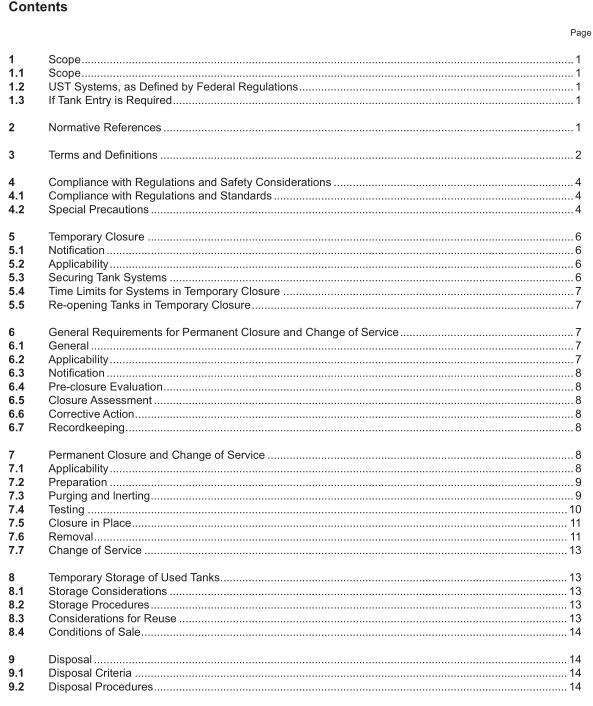API 1604 pdf download

API 1604 pdf download Closure of Underground Petroleum Storage Tanks
4.2 Special Precautions During UST removal or closure in place, workers may be exposed to petroleum hydrocarbon liquids, vapors, or wastes. The precautions in 4.2.1 and 4.2.2 should be observed by all individuals engaged in the procedures discussed in this recommended practice.
4.2.1? Toxicity Considerations for Petroleum Substances
4.2.1.1 General All personnel involved in the work shall be aware of appropriate health and safety precautions. When high concentrations of petroleum hydrocarbon vapors are inhaled, symptoms of intoxication may result. These symptoms, ranging from dizziness to excitement or unconsciousness, are similar to those produced by alcohol or anesthetic gases. If such efects occur, the individual shall be removed to fresh air. For minor efects of exposure, breathing fresh air or oxygen results in rapid recovery. If breathing has stopped, artifcial respiration shall be applied promptly. Medical attention shall be obtained as soon as possible. Paragraphs 4.2.1.2 and 4.2.1.3 contain special toxicity considerations for benzene and tetraethyl lead, which may be present in petroleum products or wastes found in or around USTs. Care shall be exercised to minimize exposure to these substances when they are present during the handling of used underground petroleum storage tanks. WARNING
— Tests have shown that prolonged or repeated exposure to some petroleum substances in liquid or vapor form may cause serious illness, including cancer, in laboratory animals. Although the signifcance of these test results to human health is not fully understood, exposure to petroleum substances should be minimized. The following health precautions are suggested.
a) Avoid contact with skin and inhalation of vapors.
b) Keep petroleum liquids away from eyes, skin, and mouth; they can be harmful or fatal if inhaled, absorbed
through the skin, or ingested.
c) Use soap and water or waterless hand cleaner to remove any petroleum product that contacts skin. Do not
use gasoline or similar solvents to remove oil and grease from skin.
d)Promptly wash petroleum-soaked clothes and avoid using soaked leather goods, taking care not to expose
to ignition sources.Properly dispose of rags.
e) Keep work areas clean and well ventilated.f)Clean up spills promptly.
4.2.1.2 Benzene
High occupational exposures to benzene have been associated with various human blood disorders, including anincreased risk of leukemia.Very high levels have also been known to affect the central nervous system. Benzeneadministered by mouth has induced cancer in laboratory animals in long-term tests. Benzene is rapidly absorbedthrough the skin. The Occupational Safety and Health Administration (OSHA) imposes limits on occupationalexposure and requirements concerning the communication of hazards to workers. See 29 CFR Part 1919.1000(Table A-2), Part 1910.1028, and Part 1910.1200.All exposure limit values should be based on the most currentand stringent published industry and regulatory values.
4.2.1.3 Tetraethyl Lead
This organic form of lead can cause diseases of the central and peripheral nervous system, kidneys, and blood.Skin absorption of this compound is a major route of entry into the body.The AcGlH time-weighted average is0.1 mg/1 m3 for general room air. The TLV in oSHA’s Occupational Safety and Health Standards (29 cFR Part1910.1000,Table Z-1) is 0.075 mg/1 m3.
4.2.2 Flammability and Combustibility Considerations
4.2.2.1 Flammable or combustible vapors are likely to be present in the work area.The concentration of vaporsin the tank, excavation, or work area may reach the flammable or explosive range before venting is complete anda safe atmosphere is established.Therefore, the following precautions shall be taken:
a) Restrict or eliminate all potential sources of ignition from the area (for example, hot work smoking materials,
and non-explosion-proof electrical and internal combustion equipment).
b) Prevent the discharge of static electricity during venting of flammable vapors by bonding and grounding all
metallic parts, and ensure that all hoses, ducts, or other non-metallic components are either conductive orare bonded and grounded.
c)Prevent the accumulation of vapors at ground level.Forced ventilation may be required.
Refer to NFPA 326 orAPI Standard 2015 and APl Recommended Practice 2003 for precautionary measures anddetails to follow during the vapor-freeing procedure.
4.2.2.2 A combustible gas indicator (CGl) shall be used to check for hazardous vapor concentrations in andaround the work area (see 7.4).For tanks that have been vapor freed with an inert gas, combustible gas indicatorreadings may be misleading (see 7.4.3).All open flame, spark-producing equipment, or other ignition sourceswithin the vapor hazard area, including hot work, shall be shut down. Electrical equipment (for example,pumpsand portable hand tools)used in the area shall be explosion-proof in accordance with NFPA70B class I, Divisionl, Group D, or otherwise approved for use in potentially explosive atmospheres.









